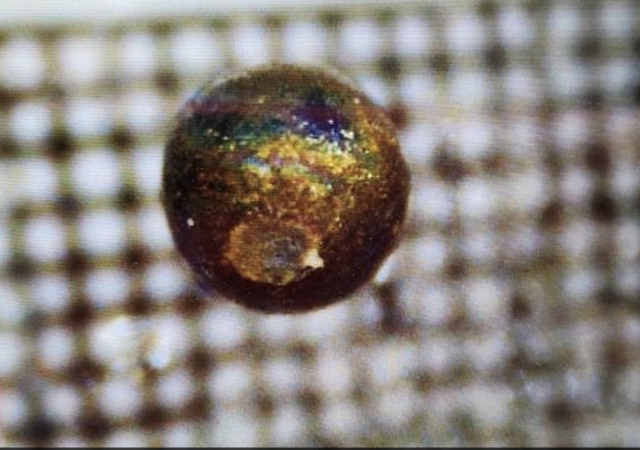Ever since he first learned about the strange meteor falling to Earth, astrophysicist Avi Loeb has been determined to discover whether it was indeed an extraterrestrial artifact that had crashed into the Pacific Ocean.
Source: USA Today
Now, the professor and theoretical astrophysicist at Harvard University says he and a team of scientists are one step closer to making that determination after they retrieved suspected remnants of the meteor in June off the coast of Papua New Guinea. On Tuesday, Loeb said in a media release that early analysis suggests that those small metallic objects actually are interstellar in origin.
The findings may not yet answer the question of whether the metallic spheres are artificial or natural in origin, but Loeb insists that the team is now confident that what they found is unmatched to any existing alloys in our solar system.
“This is a historic discovery because it represents the first time that humans put their hand on materials from a large object that arrived to Earth from outside the solar system,” Loeb wrote Tuesday on Medium, where he has been documenting the expedition and resulting studies. “The success of the expedition illustrates the value of taking risks in science despite all odds as an opportunity for discovering new knowledge.”
Metallic objects found on ocean floor during 2-week mission
Led by Loeb, the team of scientists and researchers hired EYOS Expeditions and embarked in June aboard a boat called the Silver Star bound for Papa New Guinea.
It was north of the country where for two weeks, the crew, financed with $1.5 million from entrepreneur Charles Hoskinson, sought to retrieve any remnants they could find of an unusual meteorite they named IM1 that had crashed into Earth’s atmosphere in 2014.
Data from the meteor recorded by U.S. government sensors went unnoticed for five years until Loeb and Amir Siraj, then an undergraduate student at Harvard, found it in 2019 and published their findings. It wasn’t for another three years, however, that the U.S. Space Command announced in a March 2022 letter to NASA that the object came from another solar system.
The revelation was vindication for Loeb, co-founder of the Galileo Project, a research program at the Harvard-Smithsonian Center for Astrophysics dedicated to the scientific search for alien technology. Seven months later, he and his team were 53 miles off the coast of Manus Island combing more than 100 miles of ocean floor with a sled full of magnets attached to a winch on the deck of the ship.
As fortune would have it, they found what they were looking for: more than 700 submillimeter-sized spherules through 26 runs with the sled that are so miniscule as to require a microscope to see.
“This is a historic discovery, marking the first time that humans hold materials from a large interstellar object,” Hoskinson said in a statement. “I am extremely pleased with these results from this rigorous scientific analysis.”

Loeb also theorized that comet Oumuamua was extraterrestrial
It wasn’t the first time that Loeb had theorized that an interstellar object entering our solar system could be an extraterrestrial artifact.
In 2017, the comet Oumuamua, Hawaiian for “scout” or “messenger,” was detected flying through our solar system, puzzling scientists with its strange shape and trajectory.
But Loeb posited that the comet — as long as a football field and thin like a cigar — was able to accelerate as it approached the sun by harnessing its solar power as a “light sail”, not unlike the way a ship’s sail catches the wind. Because no natural phenomenon would be capable of such space travel, Loeb was essentially suggesting that Oumuamua could have been an alien spaceship.
A study in March explained the comet’s odd orbit as a simple physical mechanism thought to be common among many icy comets: outgassing of hydrogen as the comet warmed in the sunlight.
Undeterred, Loeb also began studying around that time the fireball catalog from the Center for Near Earth Object Studies at NASA.
That led him and Siraj to discover data on IM1, which had first been detected in 2014.
Though too small to be noticed by telescopes through its reflection of sunlight, its collision with Earth generated a bright fireball recorded by U.S. government sensors. Because the meteor moved at a speed two times faster than nearly all of the stars in the vicinity of the sun, Loeb and Siraj concluded in a paper published in November in the Astrophysical Journal that the fireball, like Oumuamua, had to be interstellar.
What did the analysis reveal?
Early analysis shows that some spherules from the meteor path contain “extremely high abundances” of an unheard-of composition of heavy elements.
Researchers on the team say the composition of Beryllium, Lanthanum and Uranium, labeled as a “BeLaU” composition, does not match terrestrial alloys natural to Earth or fallout from nuclear explosions. Additionally, the composition is not found in magma oceans of Earth, nor the Moon, Mars or other natural meteorites in the solar system
Other elements are thought to have been lost by evaporation during IM1’s passage through the Earth’s atmosphere, researchers said, leading them to theorize that the spherules could originate in a magma ocean on an exo-planet with an iron core outside the solar system.
Analysis continues to figure out where the objects come from at four laboratories at Harvard University, University of California, Berkeley, the Bruker Corporation, and the University of Technology in Papua New Guinea.
Loeb also said a paper has been submitted for publication in an unnamed scientific journal.
“The findings demonstrate the success of the first exploratory expedition and pave the way for a second expedition to seek more data,” Expedition Coordinator Rob McCallum of EYOS said in a statement. “We love to enable our clients’ projects anywhere on Earth, but this one is out of this world.”
Source: USA Today

































Leave a Comment
You must be logged in to post a comment.